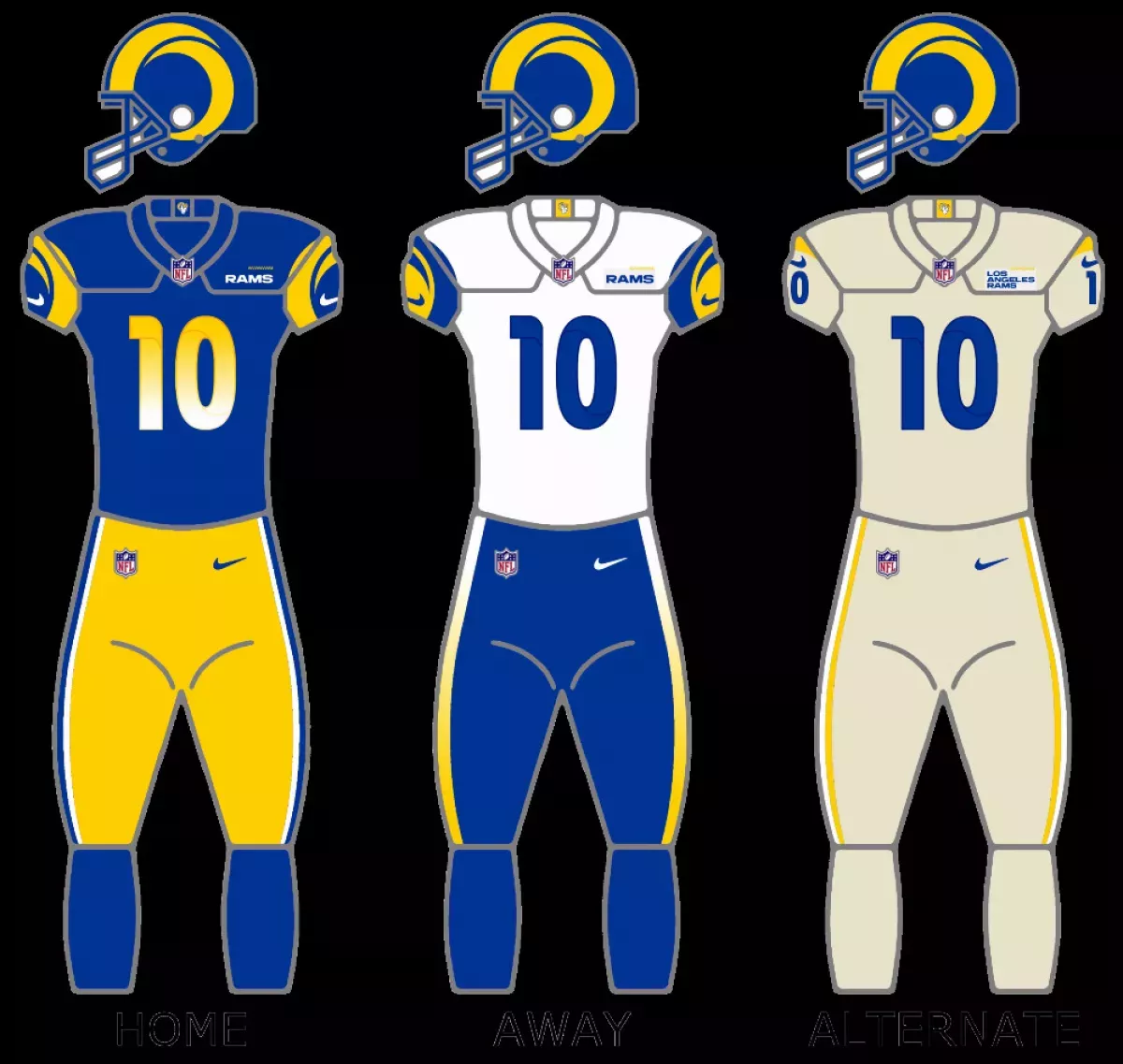The Los Angeles Rams are a professional American football team competing in the NFL as part of the NFC West division. Based in the Greater Los Angeles area, they play their home games at SoFi Stadium in Inglewood, California, shared with the Los Angeles Chargers. Their headquarters are located at the Kroenke Warner Center complex in Los Angeles. The Rams are a significant part of the Los Angeles sports scene.
1926: Los Angeles Buccaneers
In 1926, the Los Angeles Buccaneers represented L.A. but were strictly a traveling team.
1933: Joe Lillard Left the Chicago Cardinals
In 1933, Joe Lillard left the Chicago Cardinals, which started a period with no black players in professional American football that lasted until 1946.
1936: Cleveland Rams Founded
In 1936, the Cleveland Rams were founded by Homer Marshman and Damon Wetzel and finished the regular season in second place.
February 12, 1937: Joined the NFL
On February 12, 1937, the Rams joined the National Football League and were assigned to the Western Division.
1937: Rams' Original Team Colors
In 1937, when the team debuted, the Rams' colors were red and black, featuring red helmets, black uniforms with red shoulders and sleeves, tan pants, and red socks with black and white stripes.
1937: Joined the NFL
On February 12, 1937, the Rams joined the National Football League and were assigned to the Western Division.
1939: Parker Hall Named Most Valuable Player
In 1939, rookie halfback Parker Hall was named the season's Most Valuable Player.
June 1941: Rams Bought by Dan Reeves and Fred Levy Jr.
In June 1941, Dan Reeves and Fred Levy Jr. bought the Rams.
1943: Suspended Operations
In 1943, the Rams suspended operations due to a shortage of players during World War II.
1944: Resumed Operations
In 1944, the Rams resumed playing after suspending operations the previous year.
1945: Won First NFL Championship
In 1945, the Rams achieved success, winning their first NFL Championship with a 15–14 victory over the Washington Redskins. Rookie Bob Waterfield won the league's Most Valuable Player award.
1945: Won Championship Representing Cleveland
In 1945, the Rams won a championship representing Cleveland.
January 12, 1946: Approval to move to Los Angeles
On January 12, 1946, Dan Reeves was allowed to move the Cleveland Rams to Los Angeles after threatening to leave the NFL.
March 21, 1946: Signed Kenny Washington
On March 21, 1946, the Rams signed Kenny Washington, integrating the team.
May 7, 1946: Added Woody Strode
On May 7, 1946, the Rams added a second black player, Woody Strode.
1946: First Season in Los Angeles
In 1946, the Rams played their first season in Los Angeles, finishing with a 6–4–1 record.
1947: Finished Fourth in the NFC West
In 1947, Bob Snyder coached the team to a 6-6 record and a fourth place finish in the NFC West.
1947: Helmets changed to navy
In 1947, the helmets were changed to navy.
1948: First Helmet Emblem
In 1948, Fred Gehrke painted horns on the Rams' helmets, creating the first helmet emblem in pro football. In 1948, Clark Shaughnessy took over as head coach and led the team to a 6–5–1 record.
1948: Rams Introduce Logo on Helmets
In 1948, the Rams became the first NFL team to have a logo on their helmets when halfback Fred Gehrke painted ram horns on the team's leather helmets.
1948: Helmet Design Remained the Same Except for Updates to Coloring
In 2000, the helmet design essentially remained the same as it was in 1948, except for updates to the coloring, navy blue field with gold horns.
1949: All-America Football Conference ceased operations
In 1949, the Rams shared the Coliseum with the Los Angeles Dons of the All-America Football Conference until the Dons were folded into the Rams when the All-America Football Conference ceased operations.
1949: Team adopts plastic helmets
In 1949, the team adopted plastic helmets, and the horns were rendered by Riddell.
1949: Dons Folded into the Rams
Late in 1949, the Dons were folded into the Rams when the All-America Football Conference ceased operations.
1950: Blue-gold-blue tri-stripe on pants
In 1950, a blue-gold-blue tri-stripe appeared on the pants and "Northwestern University-style" royal blue stripes were added to jersey sleeves.
1950: First Team with Televised Games
In 1950, the Los Angeles Rams became the first pro football team to have all their games televised.
1950: 49ers inception and start of rivalry
In 1950, the San Francisco 49ers were founded, marking the beginning of their rivalry with the Rams, as both teams became original members of the NFC West.
1951: First Championship Game Televised Coast-to-Coast
In 1951, the NFL Championship Game featuring the Rams was the first championship game televised coast-to-coast via the DuMont Network.
1951: Won Championship Representing Los Angeles
In 1951, the Rams won a championship representing Los Angeles.
1951: Won NFL Championship
In 1951, the Rams won the NFL Championship. During the 1951 championship season, Elroy Hirsch posted a stunning 1,495 receiving yards with 17 touchdowns.
1951: Rams Wore Replicated Jerseys and Pants Replicating 1951 Championship Season
In 1994, the team's last season in Southern California, the Rams wore jerseys and pants replicating those of their 1951 championship season for their September games with the San Francisco 49ers and Kansas City Chiefs.
1952: Last postseason matchup
In 1952, was the last postseason matchup between the Rams and the Lions until 2023.
1953: White border added to numerals
In 1953, a white border was added to the blue jersey numerals.
1954: Tapered horn design
In 1954, the team had a slightly tapered horn design.
1955: Tapered horn design
In 1955, the team had a slightly tapered horn design.
1956: TV numbers added to jersey sleeves
In 1956, so-called TV numbers were added on jersey sleeves.
1957: Rams ready for regular season
In 1957, in accordance with a new NFL rule, the Rams readied new royal-blue home jerseys for the regular season.
1957: Set All-Time NFL Attendance Record
In 1957, the Rams set the all-time NFL attendance record.
1957: White Border Around Numerals Appeared in Preseason
In 1973, the new uniform design featured golden numerals with a white border around the numerals similar to the 1957 style for two preseason games before disappearing.
1958: Broke 100,000 Mark Twice
During the 1958 campaign, the Rams broke the 100,000 mark twice.
1958: Drew an Average of 83,681 Fans
In 1958, the Rams drew an average of 83,681 fans.
1958: White border was removed
In 1958, the white border was removed.
1959: Drew an Average of 74,069 Fans
In 1959, the Rams drew an average of 74,069 fans.
1960: Los Angeles Chargers Established
In 1960, the Los Angeles Chargers of the upstart AFL was established.
1961: Los Angeles Angels Awarded to Gene Autry
In 1961, the Los Angeles Angels were awarded to Gene Autry.
1962: Reeves Bought Out Partners
In 1962, Reeves bought out his partners, including Bob Hope, in the Rams ownership.
1962: Roman Gabriel Joined Rams
In 1962, Roman Gabriel joined the Rams and played 11 seasons for them.
1962: White jersey featured a blue-gold-blue crescent shoulder tri-stripe
In 1962, the team's road white jersey featured a UCLA-style blue-gold-blue crescent shoulder tri-stripe.
1963: White jersey featured a blue-gold-blue crescent shoulder tri-stripe
In 1963, the team's road white jersey featured a UCLA-style blue-gold-blue crescent shoulder tri-stripe.
1964: Uniform Colors Changed to Blue and White
In 1964, the Rams changed their colors to a simpler blue and white, with white helmet horns, blue jerseys with white numerals, and white jerseys with blue numerals. A league rule allowed the Rams to wear white jerseys for home games.
1964: Combined Record from 1957 to 1964
The team's combined record from 1957 to 1964 was 24–35–1 (.408).
1965: Sleeve "TV numbers" Reduced in Size
In 1965, the sleeve "TV numbers", quite large compared to those of other teams, were made smaller.
1966: Anaheim Stadium built
In 1966, Anaheim Stadium was originally built to be the home of the California Angels.
1966: Dick Enberg becomes play-by-play announcer
In 1966, Dick Enberg became the play-by-play announcer, replacing Bob Kelley.
1966: George Allen Led the Rams
In 1966, George Allen led the Rams and introduced many innovations.
1967: Led Rams to First or Second Place
From 1967 to 1971, Roman Gabriel led the Rams to either a first- or second-place finish in their division every year.
1967: Started a Stretch of Not Wearing Blue Jerseys
From the 10th game of 1967, the Rams started a stretch of 48 games where they did not wear their blue jerseys until the 1971 opener.
1967: Lost in 1967 to Green Bay
In 1967, George Allen would enjoy five straight winning seasons but never won a playoff game with the team, losing in 1967 to Green Bay 28–7.
1967: Reached Conference Championship
In 1967, the Rams reached the conference championship under head coach George Allen, but lost. The 1967 squad became the first NFL team to surpass one million spectators in a season.
1968: Dave Niehaus becomes analyst
In 1968, Dave Niehaus became analyst.
1969: Voted MVP of the NFL
In 1969, Roman Gabriel was voted the MVP of the NFL.
1969: Rams best start since 1969
In 2018, the Rams were the only remaining undefeated team in the NFL when they lost on the road to the New Orleans Saints in Week 9, after an 8-0 start, their best start since 1969.
1970: Allen Left Rams
After the 1970 season, George Allen left the Rams to coach the Washington Redskins.
1970: Gabriel Combined With Jack Snow
During the 1970 season, Gabriel combined with his primary receiver Jack Snow for 51 receptions totaling 859 yards.
1970: Names Appear on Jersey Backs
In 1970, in keeping with the standards of the newly merged NFL, names appeared on the jersey backs for the first time.
1970: Teams became members of the NFC West
In 1970, the 49ers and Rams became the only two teams to be a members of the NFC West since the division was formed.
1971: Led Rams to First or Second Place
From 1967 to 1971, Roman Gabriel led the Rams to either a first- or second-place finish in their division every year.
1971: Ended a Stretch of Not Wearing Blue Jerseys
The Rams ended a stretch of 48 games where they did not wear their blue jerseys with the 1971 opener.
1972: Dave Niehaus leaves as analyst
In 1972, Dave Niehaus left his position as analyst.
1972: Robert Irsay Purchased Rams
In 1972, Robert Irsay purchased the Rams for $19 million and then traded the franchise to Carroll Rosenbloom for his Baltimore Colts and cash.
1972: Roman Gabriel left Rams
In 1972, Roman Gabriel finished his 11th season for the Rams.
1972: Rams Wear Blue Jerseys for Home Games
In 1972, new owner Carroll Rosenbloom had the Rams wear their blue jerseys for most home games and announced an intention to revive the old blue and gold colors for 1973, asking fans for design ideas.
1973: Don Drysdale becomes analyst
In 1973, Don Drysdale became analyst.
1973: Won NFC West Championship
In 1973, the Rams began a streak of winning seven straight NFC West championships.
1973: Yellow-Gold Restored to Color Scheme
In 1973, yellow-gold was restored to the team's color scheme with new uniform designs featuring yellow-gold pants and curling rams horns on the sleeves.
1973: Modernized version of the Team's 1973-1999 Road Uniform Set
On July 13, 2021, the Rams unveiled a white alternate uniform, a modernized version of the team's 1973–1999 road uniform set.
1974: Lost Conference Championship
In 1974, the Rams lost their conference championship game to Minnesota.
1975: Lost Conference Championship
In 1975, the Rams lost their conference championship game to Dallas.
1975: Postseason win
In 1975, the Rams secured a postseason win.
1975: Jersey Numerals Made Thicker and Blunter
In 1975, the jersey numerals were made thicker and blunter.
1976: Rams Wear White Cleats on the Road
From 1973 to 1976, the Rams were the only team to wear white cleats on the road and royal blue cleats at home.
1976: Don Drysdale leaves as analyst
In 1976, Don Drysdale left his position as analyst.
1976: Merlin Olsen retires and stars in Little House on the Prairie.
In 1976, Merlin Olsen retired and starred in Little House on the Prairie.
1976: Lost Conference Championship
In 1976, the Rams lost their conference championship game to Minnesota.
1977: Dick Enberg leaves as play-by-play announcer
In 1977, Dick Enberg left his position as play-by-play announcer.
1977: Rams acquire Joe Namath
In 1977, the Rams acquired veteran quarterback Joe Namath from the Jets. Despite a promising start, Namath's injuries hindered his performance, leading to his departure after a defeat in Chicago. The Rams, led by Pat Haden, won the division but lost in the playoffs.
1977: Rams Wear White Cleats
Since 1977, the Rams have worn white cleats.
1978: Al Wisk becomes play-by-play announcer
In 1978, Al Wisk became the play-by-play announcer.
1978: Chuck Knox leaves, Ray Malavasi becomes head coach
In 1978, Chuck Knox departed for the Bills, leading to Ray Malavasi's appointment as head coach. The team secured their sixth consecutive NFC West title but fell short in the NFC Championship against the Cowboys.
1978: Lost Conference Championship
In 1978, the Rams lost their conference championship game to Dallas.
1978: Wore White Jerseys in Postseason Games
The team wore its white jerseys for most of its 1978 home dates, including its postseason games with the Minnesota Vikings and the Dallas Cowboys.
1979: Made First Super Bowl Appearance
At the end of the 1979 NFL season, the Rams made their first Super Bowl appearance, losing Super Bowl XIV to the Pittsburgh Steelers, 31–19.
1979: Al Wisk leaves as play-by-play announcer
In 1979, Al Wisk left his position as play-by-play announcer.
1979: Frontiere Begins Ownership
In 1979, Georgia Frontiere began her 28-year ownership of the Rams.
1979: Carroll Rosenbloom's death; Georgia Frontiere assumes ownership.
In 1979, owner Carroll Rosenbloom passed away in a drowning accident, leading to his widow, Georgia Frontiere, inheriting ownership and assuming control of the Rams operations.
1979: Conference Championship Win
In 1979, the Rams secured a Conference Championship win against the Tampa Bay Buccaneers.
1979: Won NFC West Championship
In 1979, the Rams won their seventh straight NFC West championship.
1979: First Game at the Coliseum Since 1979
On September 18, in front of over 91,000 fans at the Los Angeles Memorial Coliseum, the Rams beat the Seattle Seahawks 9–3 in their first home regular-season game in Los Angeles since 1994, and their first game at the Coliseum since 1979.
January 1980: Rams in Super Bowl XIV
In January 1980, the Los Angeles Rams made their Super Bowl XIV appearance.
1980: Bob Starr becomes play-by-play announcer
In 1980, Bob Starr became the play-by-play announcer.
1980: Rams Super Bowl Run
In 1980, Jack Youngblood played on a broken leg during the Rams' Super Bowl run, showcasing his toughness and dedication to the team.
1980: Moved to Anaheim Stadium
In 1980, the Rams moved into a reconstructed Anaheim Stadium in Orange County, California.
1980: Rams make Wild Card Spot
In 1980, the Rams posted an 11–5 record, but only managed a wild card spot and were sent packing after a 34–13 loss to the Cowboys.
1981: Rams Miss Playoffs
In 1981, age and injuries caught up with the Rams, as they missed the playoffs for the first time in nine years. Additionally, Vince Ferragamo was signed away by the CFL's Montreal Alouettes that year.
1981: Gray Face Masks Became Navy Blue
In 1981, the gray face masks became navy blue.
1982: Rams Have Worst Record in NFC
In 1982, after the season was shortened to nine games by a strike, the Rams went 2–7, recording the worst record in the NFC.
1982: Oakland Raiders Move to Los Angeles
In 1982, the Oakland Raiders relocated to Los Angeles, sharing the Los Angeles Memorial Coliseum, which divided the Rams' fan base.
1982: Wore White Jerseys Exclusively
The Rams wore white jerseys exclusively in the 1982 season.
1983: Eric Dickerson Drafted
In 1983, Eric Dickerson was drafted out of Southern Methodist University and won the Rookie of the Year award.
1983: John Robinson Hired as Coach
In 1983, John Robinson was hired as coach and cut aged veterans left over from the 1970s teams. The team rebounded to 9-7 and defeated Dallas in the playoffs, but lost to the Redskins.
1983: Raiders win Super Bowl XVIII
In the 1983 season, the Raiders were winners of Super Bowl XVIII.
1984: Eric Dickerson sets NFL Record
In 1984, Eric Dickerson rushed for 2,105 yards, setting an NFL record.
1984: Fred Dryer stars in TV series Hunter
In 1984, former Rams player Fred Dryer, took advantage of proximity to Hollywood and crossed over into acting starring in the TV series Hunter.
1984: Rams Lose to Giants in Playoffs
In 1984, the Rams made another trip to the playoffs but lost to the Giants.
1985: Rams Shut Out in NFC Championship Game
In 1985, the Rams made the NFC Championship Game after winning the division, but were shut out by the Chicago Bears.
1986: Rams Lost to Washington
After a 10–6 season in 1986, the Rams were booted from the playoffs by Washington.
1986: Dick Bass leaves as analyst
In 1986, Dick Bass left his position as analyst.
1986: Rams offense rises
In 1986, the Rams offense rose from 28th rated offense.
1987: Eric Dickerson traded to the Colts
In 1987, Eric Dickerson was traded to the Indianapolis Colts after a contract dispute.
1987: Jack Youngblood becomes analyst
In 1987, Jack Youngblood became analyst.
1987: NFL Players' Strike and "Los Angeles Shams"
In 1987, after one game of the season was lost to the players' strike, the NFL employed substitutes for the Rams, who were given the derogatory nickname "Los Angeles Shams".
1987: Hillel Slovak wears Rams hat in music video
In 1987, former Red Hot Chili Peppers guitarist Hillel Slovak wore a Rams hat in the band's music video for their single "Fight Like a Brave".
1988: Dodgers win World Series and Gretzky joins the Kings
In 1988, the Los Angeles Dodgers won the World Series, and Wayne Gretzky joined the Los Angeles Kings.
1988: Rams defeated by Minnesota
The Rams managed to return in 1988 with a 10–6 record, but then were defeated by Minnesota in the wild card round.
1989: End of an era
Although it was not apparent at the time, the 1989 NFC Championship Game was the end of an era.
1989: Bob Starr leaves as play-by-play announcer
In 1989, Bob Starr left his position as play-by-play announcer.
1989: Rams Lose to 49ers in NFC Championship
In 1989, after winning the first five games, the Rams defeated the Eagles and Giants in the playoffs, but lost to the 49ers in the NFC Championship Game.
1989: NFC Championship game
In 1989, the Rams and 49ers played in the NFC Championship game.
1990: Eddie Doucette becomes play-by-play announcer
In 1990, Eddie Doucette became the play-by-play announcer.
1990: Rams offense is 3rd in the league
In 1990, Under Zampese, the Rams offense rose steadily to 3rd in the league.
1990: Rams Crumble to 5-11
In 1990, the Rams crumbled to 5–11.
1991: Fred Dryer's run in Hunter ends
In 1991, Fred Dryer's run in TV series Hunter ended.
1991: Paul Olden becomes play-by-play announcer
In 1991, Paul Olden became the play-by-play announcer.
1991: Terry Crews Drafted by Rams in 1991
In 1991, actor Terry Crews was drafted by the Rams during his brief NFL career.
1991: Rams Have Poor Season
In 1991, the Rams had a 3-13 season.
1991: Robinson Resigns
Robinson resigned at the end of the 1991 season.
1992: Chuck Knox Returns as Head Coach
In 1992, Chuck Knox returned as head coach and led the team to a 6-10 record.
1992: Paul Olden leaves as play-by-play announcer
In 1992, Paul Olden left his position as play-by-play announcer.
1992: Jack Snow becomes color analyst
Since 1992, Jack Snow had been the color analyst since 1992, dating back to the team's original stint in Los Angeles.
1993: Bob Starr becomes play-by-play announcer
In 1993, Bob Starr became the play-by-play announcer.
1993: Knox's Run-Oriented Offense
In 1993, Knox's run-oriented offense marked the end of the Zampese tenure with a 5–11 record.
1993: Wore White Jerseys Exclusively
The Rams wore white jerseys exclusively in the 1993 season.
1994: Moved to St. Louis
After the 1994 NFL season, the Rams left Southern California and moved to St. Louis, Missouri, becoming the St. Louis Rams.
1994: Celebrity Support Before 1994 Departure
Before their 1994 departure, celebrities showed their support for the Rams.
1994: Rams Support Withers; Jerome Bettis shines
By 1994, support for the Rams had withered in Los Angeles. Jerome Bettis, nicknamed "The Battering Ram", ran for 1,429 yards as a rookie.
1994: Steve Physioc becomes play-by-play announcer
In 1994, Steve Physioc became the play-by-play announcer.
1994: Rams and Raiders leave Los Angeles
In 1994, both the Rams and Raiders left Los Angeles, with the Rams moving to St. Louis.
1994: Wore Jerseys and Pants Replicating 1951 Championship Season
In 1994, the team's last season in Southern California, the Rams wore jerseys and pants replicating those of their 1951 championship season for their September games with the San Francisco 49ers and Kansas City Chiefs.
1994: Rams last regular season game in Los Angeles
In 1994, was the team's last regular season game in Los Angeles until the team's return in 2016.
1994: First Home Regular-Season Game in Los Angeles Since 1994
On September 18, in front of over 91,000 fans at the Los Angeles Memorial Coliseum, the Rams beat the Seattle Seahawks 9–3 in their first home regular-season game in Los Angeles since 1994, and their first game at the Coliseum since 1979.
1994: Rams' Absence from Los Angeles Area Since 1994
The Rams played their first game in the Los Angeles area since 1994, a 22-year absence, with a preseason opener against the Dallas Cowboys at the Los Angeles Memorial Coliseum on August 13.
March 15, 1995: NFL Owners Reject Rams Move to St. Louis
On March 15, 1995, the NFL owners rejected Georgia Frontiere's bid to move the Rams franchise to St. Louis by a 21–3–6 vote.
1995: Rams Fanbase Withers
By 1995, the Rams fanbase in Southern California had withered. Accusations and excuses were exchanged between the fanbase, ownership, and local politicians.
1995: Rams games broadcast on KSD 93.7 FM
From 1995, the Rams games were broadcast on KSD 93.7 FM.
1995: Rams move to St. Louis
In 1995, the Rams moved to St. Louis, which lessened the geographical element of the rivalry with the 49ers, though notable matchups still occurred.
1995: Rams' First Season in St. Louis
In 1995, the Rams' first season in St. Louis, under coach Rich Brooks, resulted in a 7-9 record. Isaac Bruce was a fan favorite.
1996: Rams second season in St. Louis
In 1996, the Rams' second season in St. Louis, resulted in a 6-10 record. Isaac Bruce was a fan favorite.
1997: Dick Vermeil Hired as Head Coach; Orlando Pace Drafted
In 1997, Dick Vermeil was hired as head coach, and the Rams drafted Orlando Pace. The team went 5-11.
1998: Rams Struggle Under Vermeil
In 1998, the Rams struggled under Vermeil, going 4-12.
1999: Wore Throwback Jerseys
For the 2009 season, the Rams wore the throwback jerseys from the 1999 season against the Vikings and Texans.
1999: Kurt Warner Takes Over as Rams' Quarterback
In 1999, Trent Green's injury led Kurt Warner to become the Rams' starting quarterback, and he went on to throw for 41 touchdowns. With Warner leading the way, the Rams scored 526 points and would later become known as "The Greatest Show on Turf".
1999: Rams Establish Pass-First Identity
In 1999, the Rams established a pass-first identity that posted an NFL record number of points over the course of three seasons (1999–2001).
1999: Won Championship Representing St. Louis
In 1999, the Rams won a championship representing St. Louis.
1999: Modernized version of the Team's 1973-1999 Road Uniform Set
On July 13, 2021, the Rams unveiled a white alternate uniform, a modernized version of the team's 1973–1999 road uniform set.
1999: Celebrated Super Bowl Championship
The NFL approved the use of throwback uniforms for the Rams during the 2009 season, to celebrate the 10th anniversary of the 1999 Super Bowl championship.
1999: Rams games broadcast on KSD 93.7 FM ends
Until 1999, the Rams games were broadcast on KSD 93.7 FM.
April 12, 2000: New Logos, Team Colors and Uniforms Debuted
On April 12, 2000, the St. Louis Rams debuted new logos, team colors, and uniforms, changing the primary colors to Millennium Blue and New Century Gold.
2000: KLOU FM 103.3 becomes flagship station
From 2000, KLOU FM 103.3 became the Rams' flagship station with Steve Savard as the play-by-play announcer.
2000: Lance Goldberg Inducted into Pro Football Hall of Fame
In 2000, fan Lance Goldberg, known for wearing a watermelon on his head with horns, was inducted into the Pro Football Hall of Fame as part of the Hall of Fans.
2000: Conference Championship Win
In 2000, the Rams secured another Conference Championship win against the Tampa Bay Buccaneers.
2001: Rams Post NFL Record
From 1999-2001, the Rams posted an NFL record number of points over the course of three seasons.
2001: White Pants Worn in Pre-Season Game
In 2001, the Rams elected to wear white pants in a pre-season game in San Diego.
January 2002: Rams reach NFC Championship Game and Super Bowl XXXVI
In January 2002, the Rams reached the NFC Championship Game for the first time since January 2002, eventually advancing to Super Bowl XXXVI. This marked their first Super Bowl appearance since Super Bowl XIV in January 1980 as a Los Angeles team.
2002: Nelly music video appearance
In 2002, Nelly invited several Rams players, including Torry Holt and Marshall Faulk, to appear in the music video for his song "Air Force Ones".
2002: Saints realignment
In 2002, the New Orleans Saints played in the NFC West until the league's realignment.
2002: Seahawks Switch to NFC West
In 2002, the Seattle Seahawks switched to the NFC West, beginning their rivalry with the Los Angeles Rams.
2003: Blue Pants Worn with White Jerseys
In 2003, the Rams wore blue pants with their white jerseys for a pair of early-season games.
2004: Rams Defeat Seahawks in Wild Card Round
In 2004, the Rams defeated the Seattle Seahawks in Seattle during the NFC Wild Card round with a score of 27-20.
2004: Rams Draft Steven Jackson
In the first round of the 2004 draft, the Rams chose Oregon State running back Steven Jackson as the 24th pick.
October 2005: Jack Snow leaves the booth
In October 2005, Jack Snow left the booth after suffering an illness.
2005: Martz Hospitalized, Joe Vitt Coaches
In 2005, head coach Martz was hospitalized for several games, allowing assistant head coach Joe Vitt to coach the remainder of the season.
January 2006: Jack Snow's death
In January 2006, Jack Snow died.
2006: Scott Linehan Takes Control
After the Rams fired Martz, former Minnesota offensive coordinator Scott Linehan took control of an 8–8 team in 2006.
2006: Attendance Record Stood Until 2006
The all-time NFL attendance record set by the Rams in 1957 stood until 2006.
2007: Scrutiny from Players
Following the 2007 season, Linehan was already faced with scrutiny from several players in the locker room, including Torry Holt and Steven Jackson.
2007: Rams Finish with 3-13 Record
In 2007, Linehan led the Rams to a 3–13 record.
2007: Rams Wore All Possible Uniform Combinations
In 2007, the Rams wore all possible combinations of their uniforms, showcasing various pairings of blue, white, and gold jerseys and pants.
January 18, 2008: Georgia Frontiere Dies
On January 18, 2008, Georgia Frontiere died after owning the Rams for 28 years. Ownership of the team passed to her son and daughter.
September 29, 2008: Linehan Fired, Haslett Interim Coach
On September 29, 2008, Linehan was fired after the team started the season 0–4. Jim Haslett became interim head coach for the rest of the season.
October 19, 2008: Rams Beat Cowboys While Forcing Them to Wear Blue Uniforms
On October 19, 2008, the Rams wore their white jerseys and blue pants in St. Louis against the Dallas Cowboys, forcing the Cowboys to wear their "unlucky" blue uniforms, and won the game 34–14.
December 24, 2008: Devaney Promoted to General Manager
On December 24, 2008, personnel chief Billy Devaney was promoted to general manager after the resignation of Jay Zygmunt.
2008: Gold Pants Were Done Away With
In 2008, the Rams did away with the gold pants after they were used for only one regular-season game at Seattle.
2008: Fans Rank Dome as Worst NFL Stadium
In a 2008 Sports Illustrated poll, St. Louis fans ranked the Edward Jones Dome the worst of any NFL stadium.
2008: KLOU FM 103.3 ends as flagship station
Until 2008, KLOU FM 103.3 was the Rams' flagship station.
January 17, 2009: Steve Spagnuolo Named Head Coach
On January 17, 2009, Steve Spagnuolo was named the new head coach of the Rams.
May 31, 2009: Rams Offered for Sale
On May 31, 2009, Rosenbloom and Rodriguez officially offered their majority share of Rams for sale.
2009: Rams Receive First Pick in Draft
After finishing the 2009 season with a 1–15 record, the Rams received the first pick in the 2010 NFL draft.
2009: NFL Approved Throwback Uniforms
During the 2009 season, the NFL approved the use of throwback uniforms for the Rams to celebrate the 10th anniversary of the 1999 Super Bowl championship.
2009: Wore White Pants with Both Jerseys
For the 2009 season, the Rams elected to wear the white pants with both jerseys for the majority of the time, except the games where they wore the throwback jerseys from the 1999 season.
2009: 101.1 FM WXOS becomes flagship radio station
From 2009, the Rams' flagship radio station was 101.1 FM WXOS, a sports station in St. Louis affiliated with ESPN Radio.
August 25, 2010: NFL Approves Kroenke as Owner
On August 25, 2010, NFL owners unanimously approved Stan Kroenke as the owner of the Rams.
October 24, 2010: Jackson Passes Dickerson as Rushing Leader
On October 24, 2010, running back Steven Jackson passed Eric Dickerson as the franchise's career rushing leader.
October 31, 2010: Rams Wore 1999 Throwbacks and Beat the Panthers
On October 31, 2010, the Rams wore their 1999 throwbacks again when they beat the Carolina Panthers 20–10.
2010: Rivalry Gains Intensity
From 2010 onwards, the intensity of the rivalry between the Rams and Seahawks increased as the Legion of Boom-era Seahawks clashed with the Rams' Mob Squad-era teams.
2010: Rampage Becomes Official Mascot in 2010
In 2010, Rampage was voted by fans as the team's official mascot while the team was still located in St. Louis.
2010: Dickerson's Rushing Record Broken
Until 2010, Eric Dickerson remained the Rams' career rushing leader with 7,245 yards.
February 4, 2011: Bradford Named Offensive Rookie of the Year
On February 4, 2011, Sam Bradford was named the NFL's Offensive Rookie of the Year.
2011: Shahid Khan Acquires Jaguars
After the 2011 season, Shahid Khan, the original intended buyer of the Rams, acquired the Jacksonville Jaguars.
January 2, 2012: Spagnuolo and Devaney Fired
On January 2, 2012, head coach Spagnuolo and general manager Devaney were fired.
January 20, 2012: Rams to Play Game in London
On January 20, 2012, it was announced that the Rams would play one home game a season at Wembley Stadium in London for each of the next three seasons.
May 2012: Dome Ranked 7th Worst Stadium
In May 2012, the Edward Jones Dome was ranked by Time magazine as the 7th worst major sports stadium in the United States.
August 13, 2012: Rams Withdraw from London Games
On August 13, 2012, it was announced that the Rams had withdrawn from the 2013 and 2014 games in London.
October 21, 2012: Rams Wore White Jerseys and White Pants Against Packers
On October 21, 2012, the Rams wore white jerseys and white pants against the Green Bay Packers.
October 28, 2012: Rams Play Patriots in London
On October 28, 2012, the Rams played against the New England Patriots at Wembley Stadium in London.
2012: Rams Hire Gregg Williams
In 2012, the Rams hired the Saints' controversial defensive coordinator Gregg Williams, shortly before the Bountygate Scandal.
2012: Rams Ceased Wearing the New Century Gold Pants
The Rams ceased wearing the New Century gold pants after Nike took over as the NFL's uniform supplier in 2012.
2013: Rams Trade Zac Stacy
In 2015 after drafting Todd Gurley, the Rams traded Zac Stacy who had led the team in rushing in 2013 to the New York Jets.
2013: Rams Withdraw from London Games in 2013
On August 13, 2012, it was announced that the Rams had withdrawn from the 2013 and 2014 games in London.
2014: Rams Withdraw from London Games in 2014
On August 13, 2012, it was announced that the Rams had withdrawn from the 2013 and 2014 games in London.
January 5, 2015: Kroenke Partners to Develop New Stadium
On January 5, 2015, it was reported that Kroenke and the Stockbridge Capital Group were partnering to develop a new NFL stadium in Inglewood.
February 24, 2015: Inglewood Approves Stadium
On February 24, 2015, the Inglewood City Council approved the new stadium and the initiative.
March 10, 2015: Rams Trade Sam Bradford
On March 10, 2015, the Rams traded starting quarterback Sam Bradford to the Philadelphia Eagles for Nick Foles and draft picks.
December 2015: Stadium Construction Planned
Construction on the new stadium was planned to begin in December 2015.
December 17, 2015: Rams' Final Home Game in St. Louis
On December 17, 2015, the Rams defeated the Tampa Bay Buccaneers 31–23 in their final home game in St. Louis.
2015: Approval to move back to Los Angeles
After the 2015 NFL season, the team sought and received approval from the other owners to move back to Los Angeles in time for the 2016 NFL season.
2015: Rams Valued at $1.45 Billion in 2015
In 2015, Forbes magazine estimated the value of the Rams at $1.45 billion.
2015: Rams Adopt "The Mob Squad" Moniker in 2015
In 2015, during their final season in St. Louis, the Rams adopted the moniker "The Mob Squad" to tout the strength of their defense.
2015: NFL Blackout Rule Repealed
In 2015, the NFL's blackout rule, which forbade games from being shown on local television if they did not sell out, was repealed.
2015: Teams File to Move to Los Angeles
The day following the conclusion of the 2015 regular season, the Rams, Oakland Raiders, and San Diego Chargers all filed to move to Los Angeles.
2015: Stadium Lease Requirement Year
Under the terms of the lease that the Rams signed in St. Louis, the Edward Jones Dome was required to be ranked in the top tier of NFL stadiums through the 2015 season.
2015: 101.1 FM WXOS ends as flagship radio station
Until 2015, the Rams' flagship radio station was 101.1 FM WXOS, a sports station in St. Louis affiliated with ESPN Radio.
January 12, 2016: NFL Approves Rams' Move to Los Angeles
On January 12, 2016, the NFL team owners voted 30–2 to allow the Rams to return to Los Angeles.
January 15, 2016: Rams Announce Return to Los Angeles
On January 15, 2016, the Rams held a press conference to announce their return to Los Angeles to start play in the 2016 season.
February 4, 2016: Oxnard Selected for Rams Minicamp Site
On February 4, 2016, the Los Angeles Rams selected Oxnard to be the site of their minicamp, off-season team activities, and off-season program that began on April 18.
March 21, 2016: No Uniform Change Until 2019
On March 21, 2016, the Rams' COO announced there would be no uniform change for the team until 2019.
April 14, 2016: Rams Trade for First Overall Pick
On April 14, 2016, the Rams traded with the Tennessee Titans for the first overall pick in the 2016 NFL draft.
April 28, 2016: Rams Draft Jared Goff First Overall
On April 28, 2016, the Rams selected California quarterback Jared Goff first overall in the 2016 NFL draft.
June 9, 2016: Anchor station announced as KCBS-TV
On June 9, 2016, it was announced that KCBS-TV would air pre-season games not on national television.
June 2016: Rams Sell 63,000 Season Tickets
In June 2016, it was reported that the Rams had sold 63,000 season tickets, which was short of their goal of 70,000.
June 20, 2016: Radio broadcasting rights agreements announced
On June 20, 2016, the Rams announced their Los Angeles-area radio broadcasting rights agreements.
July 12, 2016: Rams Sell 70,000 Season Tickets
On July 12, 2016, it was reported that the Rams had sold 70,000 season tickets, reaching their goal.
July 2016: Rams sign Agreement with UC Irvine
In July 2016, the Rams signed a three-year agreement with UC Irvine to use the university's facilities for training camp, with an option to extend it to two more years.
July 19, 2016: Agreement reached with KWKW for Spanish-language coverage
On July 19, 2016, the Rams announced that they had reached an agreement with KWKW for Spanish-language coverage of the team.
July 29, 2016: Rams Host First Training Camp Practice
On July 29, 2016, it was reported that the Rams would host their first training-camp practice and "Rams Family Day" on Saturday, August 6 at the Los Angeles Memorial Coliseum, which was open to the public.
August 11, 2016: Rams to Wear All-White Uniforms for Five Home Games
On August 11, 2016, the Rams announced they would wear all-white uniforms for five of the team's eight home games during the 2016 season, as a nod to the Fearsome Foursome era.
September 12, 2016: Rams Lose First Game Back in Los Angeles
On September 12, 2016, the Rams played their first regular-season game since returning to Los Angeles, where they lost to the San Francisco 49ers 28–0 at Levi's Stadium.
December 12, 2016: Jeff Fisher fired as head coach
On December 12, 2016, Jeff Fisher was fired as head coach after a 4-9 start to the season, and John Fassel was named interim head coach.
2016: Nelly expresses anger at Rams' return to Los Angeles
In 2016, Nelly expressed anger at the Rams' return to Los Angeles but continued to display his support for the team.
2016: Rams Training Facility in Thousand Oaks
In 2016, the Rams conducted the remainder of its preseason practices at Cal Lutheran University in Thousand Oaks.
2016: Rams Move Back to Los Angeles
In 2016, the Rams moved back to Los Angeles after their last game as the St. Louis Rams against the San Francisco 49ers.
2016: Rams' news and highlights shown on Rams Primetime Live
In 2016, the Rams' news and highlights where shown on Rams Primetime Live on KABC-TV on Saturday nights after college football games during the regular season.
2016: Red Hot Chili Peppers pregame concert
In 2016, upon the Rams' return to Los Angeles, the Red Hot Chili Peppers performed an impromptu pregame concert for the team's first regular-season game in Los Angeles since 1994.
2016: Rams Acquire Second-Round Pick
On March 10, 2015, the Rams traded Sam Bradford and acquired a second-round pick in 2016 from the Philadelphia Eagles.
2016: Celebrity Support After 2016 Return
Since their 2016 return to Los Angeles, many film and music celebrities have shown support for the Rams.
2016: Signage Showed Variation Colored in Blue and White
Throughout the 2016 season, the Rams' signage showed a variation that was only colored in blue and white.
January 12, 2017: Sean McVay hired as head coach
On January 12, 2017, Sean McVay became the new head coach of the Rams at age 30, making him the youngest head coach in modern NFL history.
May 2017: Stadium Completion Pushed Back to 2020
In May 2017, the stadium completion was pushed back one year into 2020, pushing the rebrand back to 2020 along with it.
October 8, 2017: Wore Throwback Uniforms Against Seahawks
Fans selected the October 8, 2017, game against the Seahawks as one of two home games they would wear throwback uniforms.
November 26, 2017: Rams secure first non-losing year since 2006
On November 26, 2017, the Rams defeated the New Orleans Saints 26-20, securing their first non-losing year since 2006 and their first in Los Angeles since 1989.
December 24, 2017: Rams clinch NFC West title
On December 24, 2017, the Rams defeated the Tennessee Titans 27-23, clinching their first NFC West title since 2003 and their first in Los Angeles since 1985.
2017: Daniel Jeremiah replaced Dickerson
In 2017, NFL Network analyst Daniel Jeremiah replaced Eric Dickerson in the KCBS broadcasting team.
2017: NFL Coach of the Year for Sean McVay
In 2017, Sean McVay received the NFL Coach of the Year award.
2017: Chargers move to Los Angeles
In 2017, the Chargers moved from San Diego to Los Angeles, becoming the city's AFC team. Also in 2017, hostility erupted between the two clubs during a joint scrimmage.
2017: Rams Traded Draft Picks in 2017
On April 14, 2016, the Rams traded away their first and third-round picks in the 2017 NFL draft to acquire the first overall pick in 2016.
2017: Rams improve under Sean McVay
Since hiring Sean McVay in 2017, the Rams have been 9-1 against the Cardinals.
December 31, 2017: Wore Throwback Uniforms Against 49ers
Fans selected the December 31, 2017, game against the 49ers as one of two home games they would wear throwback uniforms.
July 27, 2018: Announced Throwback Royal Blue and Yellow Uniforms for Home Games
On July 27, 2018, the Rams announced that they would wear their throwback royal blue and yellow primary color uniform for home games at the Los Angeles Memorial Coliseum for the 2018 season.
2018: Nita Strauss joins Rams media team
In 2018, Alice Cooper guitarist Nita Strauss joined the Rams' media team and entertainment personnel, performing riffs at home games.
2018: Baker Mayfield Drafted First Overall
In 2018, Baker Mayfield was the first overall NFL draft pick.
2018: Controversial NFC Championship Game
In 2018, during the NFC Championship Game, a critical pass to Saints' receiver Tommylee Lewis was illegally broken up by Rams' cornerback Nickell Robey-Coleman, but no flag was thrown.
2018: Chargers reach AFC Divisional Round
In 2018, the Chargers experienced playoff success, making an appearance in the AFC divisional round but losing to the New England Patriots.
2018: Rams-Chiefs Game
In 2018, the Rams and Chiefs played in the third-highest scoring game of all time, considered one of the greatest in league history.
2018: Rams have strong season
In 2018, the Rams had a strong season, finishing with a 13-3 record, tying for the second-most wins in a single season in franchise history.
2018: Rams Discard "The Mob Squad" Moniker After 2018
The Rams discarded "The Mob Squad" moniker after 2018.
2019: Original Year Planned for Uniform Change
On March 21, 2016, the Rams' COO announced there would be no uniform change for the team until 2019, but was then pushed back.
2019: Temporary Home Stadium End
The Los Angeles Memorial Coliseum was the temporary home stadium of the Rams for four seasons (2016 to 2019) until SoFi Stadium was opened for the 2020 season.
March 23, 2020: Rams Unveiled New Logo Set and Color Scheme
On March 23, 2020, the Rams officially unveiled a new logo set and color scheme, including stylized "LA" lettering and new wordmarks.
May 13, 2020: Rams Revealed New Uniform Designs
On May 13, 2020, the Rams officially revealed the club's new uniform designs, including royal blue jerseys with gradient numbers and a "bone grey" road jersey.
2020: Rams Defeat Cardinals
In 2020, the Rams defeated the Cardinals 7-18, eliminating them from the postseason.
2020: Stadium Completion Pushed Back to 2020
In May 2017, the stadium completion was pushed back one year into 2020, pushing the rebrand back to 2020 along with it.
2020: SoFi Stadium Opens
The Los Angeles Memorial Coliseum was the temporary home stadium of the Rams for four seasons (2016 to 2019) until SoFi Stadium was opened for the 2020 season.
2020: Rams Move to New Stadium
The Rams moved to their new stadium in Inglewood in 2020.
2020: New Rebrand to Coincide With Stadium Opening
The team confirmed their new rebrand would take place in 2020 to coincide with the opening of their new home stadium, SoFi Stadium.
July 13, 2021: Rams Unveiled White Alternate Uniform
On July 13, 2021, the Rams unveiled a white alternate uniform, a modernized version of the team's 1973–1999 road uniform set.
2021: Rams trade for Matthew Stafford
Before Super Bowl LV was played, the Rams agreed to a blockbuster trade, dealing Jared Goff to the Detroit Lions in exchange for Matthew Stafford in 2021.
2021: Rams defeat 49ers in NFC Championship Game
During the 2021-22 season, the Rams defeated the San Francisco 49ers in a last-minute victory in that year's NFC Championship Game.
2021: Rams Valued at $4.8 Billion in 2021
In 2021, Forbes ranked the Rams fourth in NFL team values at $4.8 billion.
2021: SoFi Stadium allows fans, Rams defeat Bears
In 2021, SoFi Stadium allowed fans for the first time during the pandemic, and the Rams opened their season with a 34-14 win over the Chicago Bears.
2021: Rams Beat Seahawks in Wild Card Game
In 2021, the Rams beat the Seahawks in the Wild Card Game, with cornerback Jalen Ramsey and quarterback Jared Goff expressing their satisfaction.
2021: Won Championship Representing Los Angeles
In 2021, the Rams won a championship representing Los Angeles.
2021: Buccaneers Win Super Bowl LV in Home Stadium
In 2021, the Tampa Bay Buccaneers won Super Bowl LV in their home stadium, becoming the first team in league history to achieve this.
2021: KABC-TV televising Rams preseason games
Starting with the 2021 preseason, KABC-TV is televising Rams preseason games, along with the weekly Rams 360 show.
May 2022: Stan Kroenke Purchased Property in Woodland Hills
In May 2022, Rams owner Stan Kroenke purchased a 34-acre property in Woodland Hills, including The Promenade shopping mall, for approximately $150 million.
July 30, 2022: White Uniform to Supplant Bone Uniform as Primary Road Uniform
On July 30, 2022, the Rams announced that the white uniform would supplant the bone uniform as its primary road uniform.
October 14, 2022: Red Hot Chili Peppers unveil limited edition vinyl
On October 14, 2022, the Red Hot Chili Peppers unveiled a limited edition vinyl of their album Return of the Dream Canteen in the Rams' colors, commemorating the team's Super Bowl LVI victory.
2022: Rams' Struggles and Playoff Elimination in 2022
In 2022, the Rams faced injuries to key players, signed Baker Mayfield, and were eliminated from playoff contention after a loss to the Green Bay Packers, finishing with a 5-12 record after a Week 18 loss to the Seahawks.
2022: Rams NFC Divisional Round win against Buccaneers
In 2022, the Rams first met the Buccaneers in the NFC Divisional round, winning that matchup. That year the Los Angeles Rams would win Super Bowl LVI in their home stadium
2022: Rams give up first round pick
In 2022, the Rams gave up a 2021 third-round pick and two first-round picks.
2022: Rams secure postseason win against Cardinals
In 2022, the Rams secured a postseason win against the Arizona Cardinals with a 34-11 victory.
2022: Rams 2022 Season
The Rams' 2022 season included a Super Bowl victory celebration, a loss to the Buffalo Bills, a close win against the Atlanta Falcons, a win against the Arizona Cardinals, and losses to the San Francisco 49ers and Dallas Cowboys, leading to an even record after defeating the Carolina Panthers.
January 2023: Kroenke Acquired The Village Shopping Center
In January 2023, Stan Kroenke bought The Village shopping center for $325 million, bringing the total property ownership to 100 acres.
2023: Cowboys lead the all-time series
As of the 2023 season, the Dallas Cowboys lead the all-time series against the Rams 20-18.
2023: Rams lead series
As of the 2023 season, the Los Angeles Rams lead the all-time series against the Tampa Bay Buccaneers 19-10.
2023: Cooper Kupp's Hamstring Injury
In 2023, Cooper Kupp had a hamstring injury that caused him to miss games.
2023: Rams and Lions meet in the playoffs
In 2023, the Rams and Lions met for their first postseason matchup since 1952. The Lions won 24-23.
2023: Rams give up first round pick
In 2023, the Rams gave up a 2021 third-round pick and two first-round picks.
2023: Rams' 2023 Season Begins
In 2023, the Rams started their season with a win against the Seahawks, rookie Puka Nacua had a strong debut, Cam Akers was traded to the Vikings, Kyren Williams excelled, and the Rams lost to the 49ers.
2023: Robert Woods Traded to Tennessee Titans
In 2023, wide receiver Robert Woods was traded to the Tennessee Titans for a late-round pick after missing a majority of the previous season due to a torn ACL.
March 15, 2024: Aaron Donald Announces Retirement
On March 15, 2024, Aaron Donald, a Rams defensive tackle, announced his retirement after ten seasons.
2024: Rams lead the series
As of the 2024 season, the Rams lead the all-time series against the Detroit Lions 45-43-1.
2024: Aaron Donald's Contract Restructured
In 2024, Aaron Donald's contract was restructured, increasing his guaranteed money to $95 million through the 2024 NFL season.
2024: Rams Free Agency Acquisitions in 2024
In 2024, the Rams acquired cornerback Darious Williams and safety Kamren Curl, signed Jimmy Garoppolo, and cornerback Tre'Davious White.
2024: Rams' 2024 Season Start and Injuries
In 2024, the Rams began their season with an overtime loss to the Lions, followed by injuries to key players and a 1-4 record, including a win against the 49ers. Tre'Davious White struggled and was replaced by Ahkello Witherspoon.
2024: Rams Draft Jared Verse and Braden Fiske
In 2024, the Rams selected Jared Verse and Braden Fiske in the NFL draft.
January 13, 2025: Wild Card Game Relocated and Won
On January 13, 2025, the Rams' Wild Card game against the Vikings was relocated to State Farm Stadium in Arizona due to wildfires in Los Angeles. The Rams won the game 27-9.
February 6, 2025: Rams to Host 2026 NFL Melbourne Game
On February 6, 2025, the NFL announced that the Rams would be the home team for the 2026 NFL Melbourne Game, which will be the first regular season NFL game played in Australia.
2026: Rams to Play in Melbourne in 2026
The Rams will be the designated home team for the 2026 NFL Melbourne Game at the Melbourne Cricket Ground.
Mentioned in this timeline
The Kansas City Chiefs are a professional American football team...

Wayne Gretzky a Canadian former professional ice hockey player widely...
California is a U S state on the Pacific Coast...
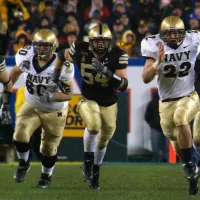
College football is a popular amateur sport in the United...
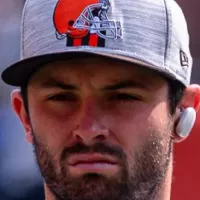
Baker Mayfield is an American football quarterback currently playing for...

SoFi Stadium located in Inglewood California is a multi-purpose indoor...
Trending
Keldon Johnson is an American professional basketball player currently playing for the San Antonio Spurs in the NBA Prior to...
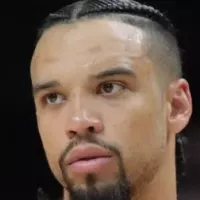
6 months ago Potential NBA Trades: Dillon Brooks, DeMar DeRozan, and the Rockets' Draft Pick
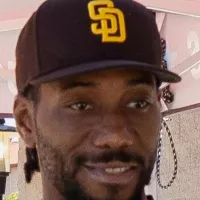
5 months ago Clippers provide update on Kawhi Leonard's condition after injury struggles, future plans.

1 month ago Jason Statham's 'A Working Man' achieves streaming success despite mixed reviews, replacing The Beekeeper.

2 months ago Jamal Murray and Nikola Joki? discussed by David Adelman; Nuggets face Warriors and Suns.
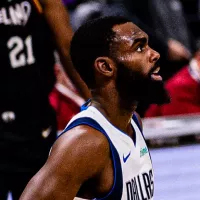
8 months ago Tim Hardaway Jr. aims to continue father's playoff success, reflecting on impressive NBA career.
Popular
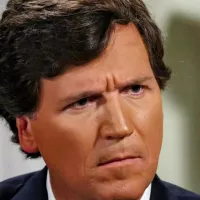
Tucker Carlson is an American conservative political commentator known for...

XXXTentacion born Jahseh Dwayne Ricardo Onfroy was a controversial yet...

Candace Owens is an American conservative political commentator and author...

Ben Shapiro is a prominent American conservative political commentator media...
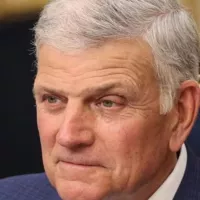
William Franklin Graham III commonly known as Franklin Graham is...

John F Kennedy JFK was the th U S President...
